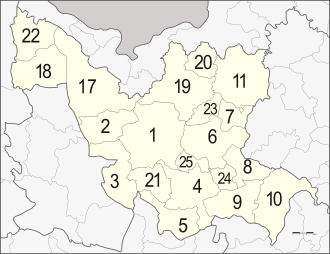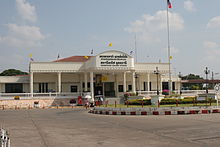Udon Thani Province
Udon Thani Province (Thai: อุดรธานี, pronounced [ʔù.dɔ̄ːn tʰāː.nīː]) is one of Thailand's seventy-six provinces (changwat) which lies in upper northeastern Thailand, also called Isan. It is bordered by the provinces of Nong Khai to the north, Sakon Nakhon to the east, Kalasin Province to the southeast, Khon Kaen to the south, and Loei and Nong Bua Lamphu to the west. It occupies an area of 11,072 km2 (4,275 sq mi). The total forest area is 1,131 km2 (437 sq mi) or 10.2 percent of provincial area.[2] The provincial capital is Udon Thani, the major city in the province.
Contents
Toponymy
Udon Thani is said to mean 'northern city'. Udon is derived from utara in Sanskrit, meaning 'northern direction', as Udon Thani is northeast of Bangkok. Thani means 'city'.
History
Udon Thani first came to historical notice in the Rattanakosin era, when Anuwong of Vientiane staged a rebellion against Thai rule and marched his army to Nakhon Ratchasima in 1826. He captured the city by a ruse, but the garrison he left to hold it unexpectedly met with fierce resistance from the disarmed local forces led by Lady Mo, the wife of Nakhon Ratchasima's governor. Anuwong advanced as far as Saraburi, but was forced to retreat. The Thai army pursued him, and the rival forces met in battle at Nong Bua Lamphu, a small city near today's Udon Thani. After two days of fierce fighting, Anuwong's army was defeated and fled back to Laos.[5]

Once known as Ban Mak-kaeng, Udon Thani was originally settled as a military base established by Prince Prachaksinlapakhom to suppress an uprising in the northeastern city of Lao Puan. Ban Mak-kaeng grew slowly from a small rural town to become what is now the city of Udon Thani. He founded Udon Thani town in 1893, established the civil administration and served important official duties for the region.[6]
In Siamese revolution of 1932, Udon Thani became Udon Thani province until now.

The province is best known for the prehistoric archaeological site at Ban Chiang and its Bronze Age relics, in a hamlet about 50 kilometers (31 mi) east of Udon Thani. Udon Thani is one of the more bustling markets for agricultural goods in the relatively dry northeast of Thailand.
Udon Thani received its biggest economic boost in the 1960s when the United States built the Udorn Royal Thai Air Force Base as a joint-force military base during the Vietnam War. The Mel Gibson film Air America depicts Udon and includes scenes of Udon's air base. Udon Thani was also the largest base in the region for the CIA's anti-communism campaign in Thailand and Laos.[citation needed] The United States turned the base over to the Royal Thai Air Force in 1976, but its presence left three residual effects on Udon. First, a large number of locals had been paid comparatively well and had learned basic conversational English. This made them more marketable to the outside world, and a significant number went to work in Middle East oilfields. Second, the base created long-standing ties with the United States, including a US consulate in Udon (closed in 1995), and a US Veterans of Foreign Wars post. But most importantly, the base and the consulate made the city into a regional hub for the northeast, and this continues today.[citation needed]
In recent years Udon received international attention because of the discovery of large potash deposits.[7] Some anticipate the region would become a major exporter of the mineral. However, granting the necessary approvals has been substantially delayed due to public opposition to mining. Many villagers living near the proposed mine site fear that the mining company's environmental impact assessment (EIA) did not adequately address the problems of salinization of the groundwater and soil, as well as probability of land subsidence. Either of these would seriously threaten the economic stability of local communities that depend on rice farming for income. An existing potash mine, Udon North mine has attracted local opposition.
Black site
The province has been named as the locale of a US CIA "black site" used to interrogate suspected terrorists by the United States.[8] Suspected locations include Ramasun Station, dominated by a large wullenweber array,[9][10] also known as the 7th Radio Research Field Station,[11] in Tambon Non Sung of Mueang Udon Thani District; the 13th Artillery Battalion encampment (Camp Yutthasilpprasit[12]) 13 km distant from Ramasun; Udorn Royal Thai Air Force Base; and a Voice of America (VOA) broadcasting station in Ban Dung District.[9]
Administrative divisions
Provincial government

The province is divided into twenty districts (amphoe). Another five are now in Nong Bua Lamphu Province. The districts are further subdivided into 155 sub-districts (tambon) and 1682 villages (muban):
Local government
As of 26 November 2019 there are:[13] one Udon Thani Provincial Administrative Organization - PAO (ongkan borihan suan changwat) and 71 municipal (thesaban) areas in the province. The capital Udon Thani has city (thesaban nakhon) status.[14] Further Ban Dung, Nam Kham-Nong Sung and Nong Samrong have town (thesaban mueang) status and 67 subdistrict municipalities (thesaban tambon). The non-municipal areas are administered by 109 Subdistrict Administrative Organizations - SAO (ongkan borihan suan tambon).
Population and demographics
Udon Thani's geographic position in the north of northeastern Thailand and its proximity to the Laotian capital, Vientiane, has contributed to the province's rapid development as a transport and industrial hub. This has created jobs and attracted migrants from other states as well as from overseas, particularly from Indonesia, the Philippines, Vietnam, Myanmar, Bangladesh, India, Pakistan, and China. In recent decades, the influx of illegal immigrants, particularly from Vietnam, has further swelled Udon Thani's population.[citation needed]
Udon Thani had a population of 1,548,107 as of 2010. The province's ethnic composition consists of Lao, Chinese, and other ethnic groups.[citation needed] The most populated cities in Udon Thani as of 2010[citation needed] are:
Transportation

Udon Thani is linked to the rest of Thailand by comprehensive air, road and rail connections. Most of the major highways that run through the northeastern Thailand, including Mittraphap Road, serve Udon Thani as well.
Air
Udon Thani International Airport, the province's primary airport, is in the district of Mueang Udon Thani near the border with Nong Khai Province. Between them, several airlines operate over 160 flights per week (as of August 2017) to Bangkok.[15]
Rail
Udon Thani railway station is the main railway station in Udon Thani.
Education
Udon Thani has several tertiary education institutions, and is also home to an international school. Most of these academic centers are concentrated in major towns and cities in Udon Thani:
Public universities
Private universities and university colleges
International schools
Healthcare
Notable hospitals in Udon Thani are listed below:
Human achievement index 2017
Since 2003, United Nations Development Programme (UNDP) in Thailand has tracked progress on human development at sub-national level using the Human achievement index (HAI), a composite index covering all the eight key areas of human development. National Economic and Social Development Board (NESDB) has taken over this task since 2017.[4]
Media
Television
Television in Udon Thani consists of thirteen free-to-air stations, one satellite television network, and two Internet television services. Seven of the thirteen free-to-air stations are broadcast from Laos (with four foreign relay stations). All of Thai stations are broadcast from Bangkok, except for NBT which has two hours of local programming.
- MCOT
- National Broadcasting Services of Thailand (NBT)
- Royal Thai Army
- Public
- Lao National Television
- LNTV 1
- LNTV 3
- MV Lao
- Vietnam Television
- China Central Television
- UDTV
- Nation Channel (Alternative News Network)
Radio
Radio stations in Udon Thani are available on FM frequencies.
Commercial radio stations available in Udon Thani include Radio One (88.5), New Music (89.0), Cool FM (89.3), SR Radio (89.9), UFM (90.25), Kiss FM (90.75), NN Radio (91.75), Big FM (92.5), Udon FM (97.0), Nice FM (97.25), Live Hits (98.0), WOW FM (98.25), Sayamchai FM (98.5), OK Love (100.0), P Radio (104.4), Mittaphap FM (104.75), Isama Radio (105.25), Wansabai Radio (106.5), and Hit FM (107.0). Commercial radio stations are operated by a few media companies.
Local community radio stations include Rajabhat University Radio (107.7) operated by Udon Thani Rajabhat University (only available in Udon Thani and Phen), EFM (101.25), and Education Radio (96.0) which targets university students.
The seven government radio networks available are Modern Radio (91.5), NBT (93.75), Parliament FM (87.5), Post FM (99.0), Border Patrol FM (100.25), Police FM (105.75). The regions of Udon Thani that border other provinces can also receive two other MCOT radio stations; Khon Kaen FM (Udon Thani-Khon Kaen border) and Nong Khai FM (Udon Thani-Nong Khai border).
Radio stations from Laos available are LNR 1 (103.7), LNR 2 (97.3), and Vientiane City Radio (105.5).
Sister cities
- Lusaka , Zambia
Image gallery
References
- "ประกาศสำนักนายกรัฐมนตรี เรื่อง แต่งตั้งข้าราชการพลเรือนสามัญ" [Announcement of the Prime Minister's Office regarding the appointment of civil servants] (PDF). Royal Thai Government Gazette. 137 (Special 194 Ngor). 36. 24 August 2020. Retrieved 13 April 2021.
- "ตารางที่ 2 พี้นที่ป่าไม้ แยกรายจังหวัด พ.ศ.2562" [Table 2 Forest area Separate province year 2019]. Royal Forest Department (in Thai). 2019. Retrieved 6 April 2021, information, Forest statistics Year 2019, Thailand boundary from Department of Provincial Administration in 2013CS1 maint: postscript (link)
- รายงานสถิติจำนวนประชากรและบ้านประจำปี พ.ส.2562 [Statistics, population and house statistics for the year 2019]. Registration Office Department of the Interior, Ministry of the Interior. stat.bora.dopa.go.th (in Thai). 31 December 2019. Retrieved 26 February 2020.
- Human achievement index 2017 by National Economic and Social Development Board (NESDB), pages 1-40, maps 1-9, retrieved 14 September 2019, ISBN 978-974-9769-33-1
- Udon Thani Provincial Office (1985), Udon Thani: A History of a Provincial Administration, Bangkok: Amarin Printing.
- "The Monument Of Krommaluang Prachaksinlapakhom". Tourism Authority of Thailand. Retrieved 11 May 2021.
- "ASIA PACIFIC POTASH CORPORATION LIMITED OVERVIEW OF UDON THANI POTASH PROJECT". Asia Pacific Potash Corporation. Retrieved 12 June 2018.
- "Torture and secrecy in Thailand". Australian Broadcasting Corporation (ABC). 17 Mar 2018. Retrieved 27 August 2018.
- Nanuam, Wassana (27 August 2018). "Ex-US base 'not secret prison'". Bangkok Post. Retrieved 27 August 2018.
- "Ramasun Camp History Museum". Thailand Tourism Directory. Retrieved 27 August 2018.
- Lelyveld, Joseph (1974-06-26). "U.S. Military Presence Is in Asia as of Old, but Justification for It Is All New". New York Times. Retrieved 27 August 2018.
- Sarnsamak, Pongphon (2012-05-16). "Keep away from our base, army warns miners". The Nation. Retrieved 27 August 2018.
-
"Number of local government organizations by province". dla.go.th. Department of Local Administration (DLA). 26 November 2019. Retrieved 10 December 2019.
72 Udon Thani: 1 PAO, 1 City mun., 3 Town mun., 67 Subdistrict mun., 109 SAO.
- "พระราชกฤษฎีกา จัดตั้งเทศบาลนครอุดรธานี จังหวัดอุดรธานี พ.ศ. ๒๕๓๘" [Royal Decree Establishing Udon Thani city municipality, Udon Thani province, B.E.2538 (1995)] (PDF). Royal Thai Government Gazette. 112 (40 Kor): 6–9. 24 September 1995. Retrieved 10 March 2020, effectively on 25 September 1995
- "Udon Thani Airport Guide". Netmobius. Retrieved 7 August 2017.
External links
- Official website
- Udon Thani travel guide from Wikivoyage